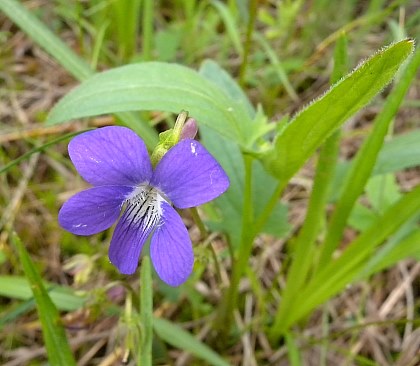
The blooming period occurs from mid-spring to early summer and lasts about 3-4 weeks. Later in the summer, fertilized flowers are replaced by light green seed capsules about 1/3" long that are oblongoid-ellipsoid in shape. At maturity, each capsule divides into 3 parts, ejecting its seeds. During the summer, cleistogamous (self-fertile) flowers are also produced that lack petals and remain inconspicuous; these flowers also develop into seed capsules that split open at maturity. The root system consists of a short narrow crown with fibrous roots; sometimes rhizomes also develop that form clonal offsets.
Cultivation: The preference is full or partial sun, moist to dry-mesic conditions, and soil containing loam, clay, rocky material, or sand.

Range & Habitat: The native Arrow-Leaved Violet is occasional in most areas of Illinois (see Distribution Map). Habitats include sand prairies, sandy shrub prairies, clay prairies, riverbanks, rocky upland woodlands, limestone or sandstone glades, and abandoned fields containing heavy clay soil. Arrow-Leaved Violet benefits from occasional disturbance that reduces the encroachment of woody vegetation.
Faunal Associations: Robertson (1929) observed two bees, Osmia pumila and Andrena violae, and a butterfly, Colias philodice (Clouded Sulfur), visiting the flowers of Arrow-Leaved Violet. These floral visitors were seeking either nectar or pollen. Other insects feed on the foliage, plant juices, and other parts of violets. The caterpillars of several Fritillary butterflies feed on violets: Boloria bellona (Meadow Fritillary), Boloria selene myrina (Silver-Bordered Fritillary), Euptoieta claudia (Variegated Fritillary), Speyeria aphrodite (Aphrodite Fritillary), Speyeria atlantis (Atlantis Fritillary), Speyeria cybele (Great Spangled Fritillary), and Speyeria idalia (Regal Fritillary). Other insect feeders include caterpillars of the moths Elaphria grata (Grateful Midget) and Eubaphe mendica (The Beggar), Aulacorthum circumflexum (Crescent-Marked Lily Aphid) and Neotoxoptera violae (Violet Aphid), the larvae of Ametastegia pallipes (Viola Sawfly), and the thrips Odontothrips pictipennis. Among vertebrate animals, the seeds of violets are eaten by such birds as the Ruffed Grouse, Wild Turkey, Bobwhite, and Mourning Dove. The White-Footed Mouse and probably other small rodents also eat small amounts of the seeds. The foliage is browsed to a limited extent by the Cottontail Rabbit and Wood Turtle (Clemmys insculpta).
Photographic Location: A sandy shrub prairie at Kitty Todd Nature Preserve in NW Ohio.
Comments: The leaves of this violet have a distinctive arrowhead shape, while its flowers resemble those of many other violets. Arrow-Leaved Violet is most similar to the Sand Violet (Viola fimbriatula), which is sometimes considered a variety of Arrow-Leaved Violet, or Viola sagittata ovata Unlike the Arrow-Leaved Violet, the Sand Violet has hairy petioles, hairy flowering stalks (pedicels), and its leaf blades tend to be more hairy as well. The leaf blades of Sand Violet are also shaped differently: they tend to have tips that are more blunt and less conspicuous basal lobes. In some areas, one may encounter plants that display some degree of hybridization between these two species (or varieties).